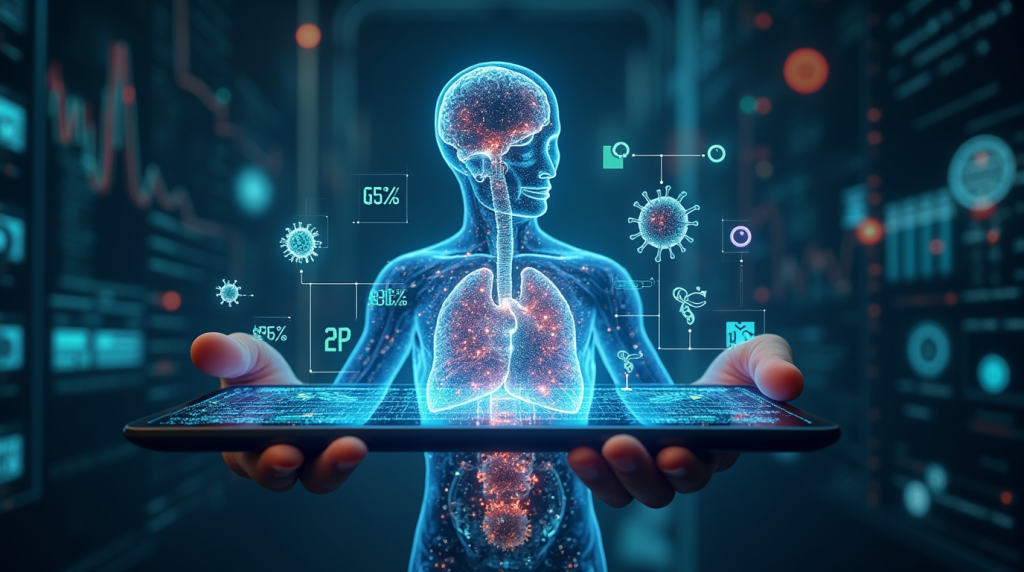The AI Revolution in Healthcare
The healthcare sector is undergoing a seismic shift, powered by artificial intelligence (AI) and machine learning (ML). According to a 2024 report by the World Health Organization (WHO), AI-assisted diagnostics reduce medical errors by up to 30%, while improving detection rates for life-threatening conditions like cancer and heart disease.
AI is no longer a futuristic concept—it’s being deployed in hospitals, research labs, and telemedicine platforms worldwide. From analyzing medical images with superhuman accuracy to predicting disease outbreaks before they happen, machine learning is redefining how we diagnose and treat illnesses.
This in-depth guide explores how AI is transforming medical diagnostics, its real-world applications, ethical considerations, and what the future holds for AI-driven healthcare.

1. How AI is Revolutionizing Medical Imaging
AI in Radiology: Faster, More Accurate Scans
Radiology is one of the most AI-affected medical fields. Deep learning algorithms can now analyze X-rays, MRIs, and CT scans with 95% accuracy, matching or surpassing human radiologists (Nature Medicine, 2024).
Key Advancements:
- Early Cancer Detection: AI identifies tumors at Stage 0, improving survival rates.
- Automated Anomaly Detection: Flags fractures, hemorrhages, and lesions in seconds.
- Reduced False Positives: AI minimizes overdiagnosis, preventing unnecessary biopsies.
“How AI is Changing Radiology”
For more on AI in radiology, read our guide on AI-Powered Medical Imaging.
2. AI in Pathology: The Rise of Digital Biopsies
From Microscopes to Machine Learning
Traditional pathology relies on manual examination of tissue samples—a slow, error-prone process. AI-powered digital pathology automates this, analyzing whole-slide images (WSI) with 99% precision (Journal of Pathology Informatics, 2023).
Applications:
- Cancer Subtyping: AI distinguishes between benign and malignant cells.
- Predictive Pathology: Forecasts disease progression based on tissue patterns.
- Global Collaboration: Pathologists worldwide share AI-annotated cases in real time.
Statistic:
The FDA has approved over 50 AI-based pathology tools since 2022 (FDA.gov).
3. AI-Powered Predictive Diagnostics
Forecasting Diseases Before Symptoms Appear
Machine learning models analyze electronic health records (EHRs), genetics, and lifestyle data to predict:
- Heart attacks (up to 5 years in advance)
- Diabetes onset (with 85% accuracy)
- Neurodegenerative diseases like Alzheimer’s
A 2023 study in The Lancet Digital Health found that AI predicts sepsis 12 hours earlier than traditional methods (source).
Learn how Predictive AI is Shaping Preventive Medicine.
4. AI in Genomics: Personalized Medicine at Scale
Decoding DNA with Machine Learning
AI accelerates genome sequencing from weeks to hours, enabling:
- Cancer Risk Scoring: Identifies high-risk mutations (BRCA, TP53).
- Drug-Gene Matching: Predicts medication responses.
- Rare Disease Diagnosis: Analyzes exome data for elusive conditions.
Statistic:
The global AI genomics market will hit $9.7 billion by 2027 (Grand View Research).
5. Ethical Challenges & Limitations
Bias, Privacy, and the “Black Box” Problem
While AI offers immense potential, key concerns include:
- Algorithmic Bias: Models trained on non-diverse datasets may misdiagnose minorities.
- Data Privacy: HIPAA-compliant AI is critical for patient trust.
- Explainability: Many AI systems operate as “black boxes,” lacking transparency.
Regulatory Progress:
The EU’s AI Act (2024) mandates strict validation for medical AI tools (European Commission).

Conclusion: The Future of AI Diagnostics
AI is not replacing doctors—it’s augmenting human expertise. As machine learning evolves, we’ll see:
✔ Faster, cheaper, and more accurate diagnoses
✔ Democratized healthcare access via telemedicine AI
✔ Fully personalized treatment plans
What’s Next? Explore our AI in Healthcare 2025 Report for cutting-edge developments.
References & Further Reading
The diagnostic revolution is here—and AI is leading the charge.
